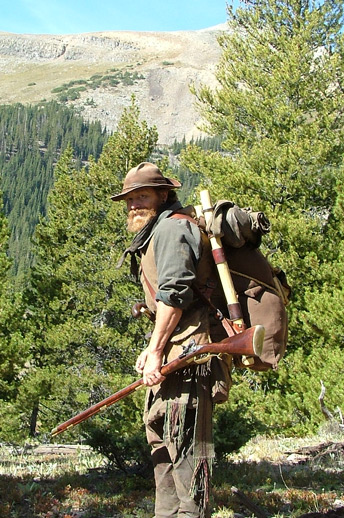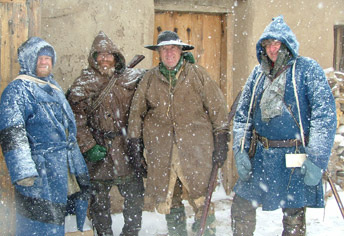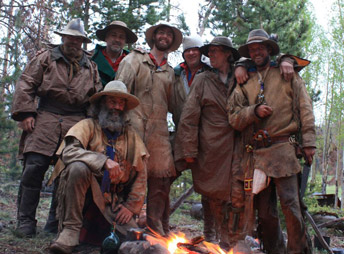Rocky Mountain Outfit — American Mountain Men (AMM) party of Colorado
Nathan Blanchard
My AMM Requirements
This is the documentation for the requirements that I have done to advance to a Bossloper member of the AMM. Officially I became a Pilgrim member of the AMM in December of 2010. I advanced to Bossloper in February 2012. My number is #2039.
-
Must have a full set of hand-cut and -sewn clothing and handmade accoutrements. These must be researched for authenticity of the 1800-40 period and be of a type which would have been seen on men in, or moving to, the Rocky Mountains. Rifles, saddles, traps, blankets, and other accoutrements that would normally have required the work of a specialized craftsman need not be handmade, but must be as authentic as can be purchased today.

My clothing consists of a pair of brain tan leggings, canvas drop front fall pants, linsey woolsey undershirt, canvas shirt, wool shirt, mits for times of cold made of wool, low crown hat, wool hat for winter and night, brogans for my feet when putting in the miles, mocs when the conditions warrant, and both a wool and cotton scarf.
As a hunter-guide-scout the accoutrements I typically carry consist of a 50 caliber Leman flintlock rifle, 45 caliber pistol, lO-inch butcher knife for heavy work and a French style 7-inch bone handle Boucheron knife for everyday work and skinning. Depending on my mode of transportation I may carry a pole ax for heavy camp work and or a boarding ax for skinning and warfare. On my belt I carry a brain tan belt bag that consist of small primer, caps, folding knife, compass, and several ball boards. Across my shoulder I carry a brain tan bag that consists of flint and steel, dry tinder, rifle tools, ball mold and bar lead. On the outside I carry my powder in a buffalo powder horn. My bedroll consists of two four point wool blankets and some oil cloth.
Sources:
- Journal of a Trapper; or Nine years in the Rocky Mountains 1834-1843, Osborne Russell
- Rocky Mountain Life, Rufus Sage
- The Hawken Rifle: It's Place in History, Charles Hansen
- Clothing of the Rocky Mountain Trapper 1820-1840, Alan Chronister and Clay Landry, Book of Buckskinning
- Mountain Man Sketchbooks, Charles Hansen
- The 1837 Sketchbook of the Western Fur Trade, Rex Allen Norman
- Various Fur Trade Inventories
-
Must have spent at least two days and one night in a primitive camp during
each season of the year.
Winter: January 14 – 16, 2011
This camp was attended by Steve Chin, Tom Karnuta, Darko, Rick Lesquier, Scott Walker and Bill Gantic. This camp was on the AMM Land and was a pack in camp using three horses and a mule provided by Steve. On this camp I demonstrated my ability to pack and lead a mule as well as my ability to provide and cook meat for the camp in a period fashion.Spring: April 29 – May 1, 2011
Attended by Bill Gantic, Steve Chin and Tom Karnuta. No turkeys were taken at the camp and Steve Chin was a bit ill. This allowed us to work as a team to get Steve and his gear into camp. This camp was located on the opposite side of the Arkansas River. To navigate the crossing we had to securely pack our gear into a canoe and then navigate across a swift current to the opposite side. We woke to a thin blanket of snow on Sunday.Summer: AMM Nationals Beaver Creek
Spent the entire week at AMM Nationals in Beaver Creek Utah. Bill Gantic, Brad Baily, Tom Karnuta and Steve Chin all represented the RMO. Bill Bailey from the Baker Party was also in attendance. I attended colleges on period fishing, Indian sign and Henry Rifles. In addition to meeting many new brothers I also had the opportunity to help put on the primitive shoot. This is what rendezvous are all about. Bents Old Fort, December 2011
Bents Old Fort, December 2011
Fall: December 2 – 4, 2011
Bents Fort: This was a combined camp with the Baker Party of Colorado and was attended by Bill Gantic, Tom Karnuta, Tom Chalmers, Scott Walker, Steve Chin, representing the RMO. Mike Moore, Jim Sebastrain and Bill Bailey all represented the Baker Party. Also from all the way from Iowa and the Missouri River Party was Denny Leanord and his trail partner Joe. This camp also ran concurrent with the annual Holiday Celebration at Bent's Fort. During the weekend both during the day and evening, the fort was open to the public. Members of the AMM had a hunter/trapper camp along the Arkansas and help the public better understand the fur trade period. At this event we portrayed the buffalo robe era which was a very busy time in 1846 for Bent's Fort. Once again we had snow and darn cold weather. With the exception of AMM Nationals in Utah we had snow at every camp I attended during 2011. Proper gear and shelter is truly important during any season in Colorado. Life in the Rockies! - Must have spent an accumulative time of two or more weeks in the wilderness under primitive conditions in the company of no more than one other member. Each stay must be at least three full days and two full nights.
-
Must have spent at least one full week in a primitive encampment in the
company of other members at the territorial AMM Rendezvous (Eastern or
Western) and/or the National (Rocky Mountain) AMM Rendezvous.
 AMM Nationals, Utah, June 2011
AMM Nationals, Utah, June 2011
Summer 2011 Beaver Creek Utah. During this event I helped put on and run the competitive and noncompetitive shoot. As mentioned above under camps I also attended colleges, met many new brothers, had some great shrub, and kicked back at many a fine campfire. View sketches from this trip.
-
Must be able to demonstrate the skills needed for primitive survival in
the wilderness of his area and must be willing to teach said skills to
other members when requested by a Party Booshway or Director of this
Association.
I've been a primitive hunting guide in Colorado, Alaska, Idaho and Montana for 24 years. In the last several years I have taught RMO members especially one of my sponsors Tom Karnuta how to hunt, call and track elk as well as turkey. At AMM Nationals I taught proper flintlock shooting techniques to several individuals. My ability to survive with period gear was also demonstrated at our camps in 2011 where it seems snow and cold was the norm.
-
Must be able to demonstrate trapping ability using steel traps, snares,
and traps made from natural materials found in the area. As many states do
not allow the use of some, or any, of these traps, the actual taking of
game is not required, although it is suggested where possible and legal.
I grew up trapping in Vermont along the Canadian boarder for beaver, muskrat, fisher cat, bobcat, and fox. The last two winters I have run a successful martin trap line were I trapped several martins each winter and sold them to a local furrier. I also demonstrated to my sponsor Tom Karnuta my ability to properly set a steel leg trap.
-
Must be able to demonstrate ability to track man or animal under natural
wilderness conditions.
As a lifelong hunting guide I have tracked under all extremes. I have tracked elk, turkey and rabbit over the past year with my sponsor Tom Karnuta. This past spring I was able to successfully use both sign and track to make a successful primitive turkey and elk kills.
-
Must be able to demonstrate the ability to properly pack a horse, canoe
(or bullboat), or a man for distance travel under possible adverse
conditions.
I grew up canoeing and packing mules most of my adult life. In the last year I demonstrated my skill of packing a mule at the Winter 2011 RMO camp. I've demonstrated canoe packing skills at the spring 2011 turkey camp, and demonstrated my skill to pack myself into several other walk in camps the furthest hike being the Spring turkey camp.
-
Must be able to properly field dress (clean and skin) a game animal under
primitive conditions.
I have been hunting, skinning and butchering for my entire life. Over past several years I've shot two deer, two elk, rabbits, grouse and turkeys with my flintlock. All were cleaned and butchered in a period style.
-
Must be able to start a fire in wet, as well as dry, weather using flint
and steel or fire drill using tinder and wood found under natural
conditions.
This has been accomplished many times over the past several years. I've demonstrated to Tom my ability to use flint/steel, burning glass and flintlock. It is the only way I start fires weather at home in the wood stove or out in the field.
- Must be able to show ability to tan or Indian-dress hides.
-
Must have spent at least five days traveling on foot, snowshoe, canoe,
and/or horseback.
- One method or a combination may be used.
- Bullboat may be used in place of canoe.
- You are expected to gain as much distance as possible.
- his trip must be under primitive conditions, taking nothing that would not have been available to the mountain man between 1800-1840. Rifle, hunting bag, powder horn, and knife must be along.
-
Must be able to cook a meal of meat using only the meat, fire, a knife,
and materials found in nature.
I've demonstrated this skill at numerous RMO camps over the past year. In fact I provided and cooked all the meat at the 2011 Winter AMM Land Camp.
-
Must be able to converse using Plains Indians hand talk. The 200 words on
page 64 of Tompkin's book "Indian Sign Language", will be used as a basis
for conversation. To complete this requirement, you must demonstrate your
ability to read the signs for 50 words, as well as to give the signs for
50 words.
I've been working and studying this skill since becoming a pilgrim. I attended a workshop put on by Teton Todd at the 2011 AMM Nationals and continue to expand on what I learned in the workshop. Tom and I are always working on this skill. I've since taught my 7 year old daughter a collection of signs and can now converse with her using these signs while hunting.
-
Must have hunted for and killed at least one game or fur animal with a
muzzleloading firearm or primitive bow and must have used the skin and/or
meat for food, clothing and/or accoutrements. The hunt must be made from a
strictly primitive camp, the hunt accomplished under primitive conditions
within the limits of local game laws.
During the past year I harvested a turkey, deer and elk from a primitive camp using either my 50 caliber flintlock rifle in the case of the deer and elk or a 20 gauge smooth bore in the case of the turkey. All the meat was used to feed myself and my family.
Nathan Blanchard
January 2012